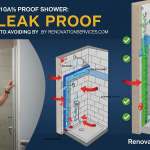My Foolproof Method for Installing Bathroom Floor Tile
The professional’s definitive step-by-step guide to installing a level, crack-free, and waterproof tile floor that will last a lifetime.
Request a Full Bathroom Renovation EstimateLast Updated: November 18, 2025
Installing floor tile is more than just sticking ceramic squares to the ground; it’s a precise process of structural engineering. In a high-vibration city like New York, where floor joists flex and concrete slabs shift due to subway traffic and building settlement, a flawed tile job is a guaranteed failure. Cracking grout, lippage (uneven edges), and chipped tiles are almost always symptoms of inadequate preparation or structural reinforcement.
This guide outlines a proven, professional methodology—a foolproof system that addresses subfloor stability, movement (uncoupling), and proper mortar coverage. We’ll show you why a laser level beats a chalk line, the trick to getting a perfect toilet flange cut, and the crucial step that prevents your leveling clips from chipping your finished tile. Whether you’re planning a DIY project or comparing options for your full bathroom renovation, mastering these techniques will ensure your tile floor is beautiful, level, and crack-free for decades.
Key Takeaways from This Guide
- Start Square: Always establish a layout line square to the most important element (usually the door or main wall) to ensure uniform cuts.
- Use Uncoupling: An uncoupling membrane (like Schluter Ditra) is mandatory to prevent concrete or wood subfloor movement from cracking your tiles.
- Back-Butter Large Tiles: Apply thin-set to both the subfloor AND the back of large tiles to achieve the required 95% coverage.
- Clean the Grout Line: Use a pencil or pick to remove thin-set squeeze-out *before* the mud dries and *before* tightening leveling clips.
- Consistency is Key: Use the same angle when combing thin-set with your trowel to ensure uniform bed thickness and full mortar contact.
Section 1: The Critical Foundation: Subfloor Preparation
The subfloor is the single most common point of failure for a tile job. You cannot tile over a weak, dirty, or shifting foundation. Your goal is a surface that is clean, dry, and structurally sound.
The Clean and Dry Rule
Before anything else, the floor must be scraped, swept, and cleaned. Scrape away any dried paint, drywall mud, or concrete lumps. Vacuum thoroughly. If your subfloor is concrete, it must be fully cured. If you have moisture or mold issues, you must address them first; consult the EPA’s guide on mold cleanup before proceeding.
Structural Integrity and Deflection
If you are tiling over a wood subfloor (plywood or OSB), especially in a basement or upper floor of an old building, stability is paramount. The floor cannot deflect (bend) more than a tiny amount under load, or your grout and tiles will crack. You must ensure you have two layers of subfloor (often 3/4″ plywood and 1/2″ cement board, or equivalent) and proper joist spacing. If you’re dealing with a bouncing floor, specialized subfloor reinforcement may be required.
Interactive Tool: Subfloor Suitability Checker
Check if your current subfloor configuration is suitable for porcelain or large-format tile.
Choosing the Thin-Set Mortar
A professional installer uses high-quality, modified thin-set. The video recommends a product like **Schluter All-Set**, which is an all-purpose modified mortar designed to bond to difficult surfaces (like plywood and uncoupling membranes) in both modified and non-modified situations. Do not use mastic or budget, non-modified thin-set; they lack the polymers needed for durability and movement control.
Section 2: Layout, Cutting, and the Uncoupling Membrane
The layout determines where your cuts fall. The goal is to start with a full tile and end with cuts that are no less than half a tile wide, placed against the least visible walls.
The Square Layout System
Your layout must be square to the room’s most visible element, usually the door.
- Find the Reference Point: Use a straight edge (like a piece of lumber or aluminum) placed against the door jamb, aligning it with the center of the door’s threshold.
- Mark the Square Line: Use a laser level or a large carpenter’s square to project a line 90 degrees (square) from your reference point into the room. This line becomes the edge of your very first tile.
- Adjust for Cuts: Dry-lay a row of tiles along this line to the opposite wall. If the cut at the wall is too small (e.g., less than 4 inches), adjust your starting line by shifting it a few inches to ensure a larger, more manageable cut at the perimeter. This minor adjustment ensures symmetry and professionalism.
Interactive Tool: Layout Cut Size Calculator
Enter your room dimensions to see the size of the cuts you will have against the far wall.
The Uncoupling Membrane System
An uncoupling membrane (the video uses a dimpled orange product) is the single most important defense against cracked tile floors in high-movement areas. The principle is simple: it allows the subfloor to move laterally (e.g., small shifts from building expansion or vibrations) without transferring that stress to the rigid layer of thin-set and tile above. It also functions as a highly effective waterproofing layer for your bathroom, a crucial component for any full waterproofing system.
The Perfect Toilet Flange Cut
This is the most common mistake for DIYers. The tile must sit flush around the flange, and the top of the flange should be level with or slightly above the finished tile floor.
- Template First: Use a piece of cardboard or a scrap tile to create a template. The video uses a temporary flange extension kit to make measurement easier.
- Measure from the Square Line: Critically, do not measure from the wall. Measure from your primary layout line (the square line you established earlier) and your perpendicular reference line to locate the center point of the flange hole on your tile.
- Cut the Hole: A rough trace is fine since the toilet base will cover the entire hole. Use a grinder or wet saw to cut the circle. Remember, the toilet must be able to sit flush on the tile, and the flange should not interfere. If necessary, hire a plumber to ensure your flange height is correct.
Section 3: Thin-Set Application and Setting the Tile
This is where the strength comes from. Proper thin-set application prevents hollow spots and guarantees maximum tile adhesion.
Mixing the Thin-Set
Mix your modified thin-set in a clean bucket using a paddle mixer attached to a drill. The consistency should be like **stiff peanut butter**—it should hold a peak without slumping. Allow the mixture to “slake” (rest) for the time recommended on the bag (usually 5-10 minutes) before mixing it one last time. Never add extra water to loosen it up; this compromises the polymers and causes the final bond to fail.
Trowel Technique: Collapsing the Ridges
The video emphasizes the correct technique: apply the flat side of the trowel to the floor first, then use the notched side. **The angle matters.** Hold the trowel at the same consistent angle (usually 45 to 60 degrees) for every tile application to ensure a uniform bed thickness. The thin-set ridges must be combed in **one consistent direction** so that when the tile is set, the ridges collapse completely, forming a continuous, void-free bond. For large format tile, you need a large trowel (1/2″ x 1/2″ or larger).
Interactive Tool: The Correct Trowel Size
Select your tile size to find the minimum recommended notched trowel size for adequate coverage.
The Necessity of Back-Butter
For any tile larger than 12×12 inches, **back-buttering** is non-negotiable. Using the flat side of a margin trowel, scrape a thin, even layer of thin-set mortar onto the entire back surface of the tile. This guarantees you achieve the **95% thin-set coverage** required by ANSI standards for wet areas like bathrooms. Without back-buttering, large tiles will inevitably have hollow spots that lead to cracking or failure under heavy load.
Leveling Clips (Lippage Control)
When installing large format, rectified tiles, using a leveling system is a professional best practice. These clips slide under the edges of adjacent tiles and use a plastic wedge to mechanically pull the faces of the tiles perfectly flush with one another. This eliminates **lippage**, ensuring a smooth, level surface, which is particularly important for high-end small bathroom designs.
Section 4: Grouting, Cleanup, and Curing
After the thin-set has cured (usually 24 hours), the final stage is grouting. A professional grout job is clean, uniform, and free of haze.
Removing Clips and the Pencil Trick
Before removing the leveling clips, you must ensure the grout lines are clean of hardened thin-set. The video demonstrates using a **standard wooden pencil** to scrape out any squeezed-out thin-set from the edges of the tiles. This prevents the clip base from being locked into the mud, which causes the plastic to break unevenly and leave a piece sticking out under the tile—a guaranteed failure point that ruins your grout line. Once clean, kick or snap off the wedges and clips.
Grout Mixing and Application
Grout must be mixed slowly with a low-speed drill or by hand until it reaches a stiff, stable consistency. Let it slake for 10 minutes, then re-mix. The longer you mix, the looser the grout gets, making it prone to shrinkage and deep grooves upon drying. Use a rubber grout float held at a **45-degree angle** to push the grout firmly into the joints, then pull the float at a 90-degree angle to scrape off the excess.
Interactive Tool: Grout Quantity Estimator
Estimate how much grout you need based on your room and grout line size.
Washing and Haze Control
Wait until the grout begins to haze (10-30 minutes). Then, use a damp (not soaking wet) sponge to gently wipe the tiles in a **45-degree angle** motion across the joints. **Flip the sponge after every single pass** and rinse it frequently in clean water. Use a two-bucket system (one for rinsing, one for clean water) to minimize haze. Any lingering haze after 48 hours will require a dedicated acid-based cleaner.
Section 5: Final Considerations and FAQ
NYC Code and Waterproofing
In NYC, especially in co-ops and condos, proper waterproofing is mandatory, not optional. The moisture and vibration require crack-isolation membranes, and proper sealing of shower and tub perimeters is essential to comply with local housing codes. Always refer to the latest NYC Housing Maintenance Code for legal requirements on bathroom maintenance and renovation. Proper bathroom ventilation is also key to preventing grout failure.
1. What is the difference between sanding and non-sanding grout?
2. Why do professionals ‘back-butter’ tiles?
3. What is the best method for sealing grout?
4. How soon can I walk on the new tile?
Interactive Tool: NYC Subfloor Moisture Check
If your subfloor is concrete, moisture can prevent the thin-set from bonding. Answer below.
Looking for a Guaranteed Flawless Floor?
Tiling a floor is precise, labor-intensive work. If you prefer a Level 5 finish without the hassle, our certified installers handle everything from structural reinforcement to the final grout seal. We specialize in high-traffic, durable full-service renovations across New York City.






